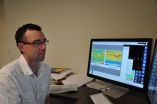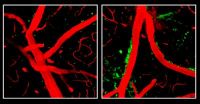(Press-News.org) Centaurus A, also known as NGC 5128 [1], is a peculiar massive elliptical galaxy with a supermassive black hole at its heart. It lies about 12 million light-years away in the southern constellation of Centaurus (The Centaur) and has the distinction of being the most prominent radio galaxy in the sky. Astronomers think that the bright nucleus, strong radio emission and jet features of Centaurus A are produced by a central black hole with a mass of about 100 million times that of the Sun. Matter from the dense central parts of the galaxy releases vast amounts of energy as it falls towards the black hole.
This Wide Field Imager (WFI) picture allows us to appreciate the galaxy's elliptical nature, which shows up as the elongated shape of the fainter outer parts. The glow that fills much of the picture comes from hundreds of billions of cooler and older stars. Unlike most elliptical galaxies, however, Centaurus A's smooth shape is disturbed by a broad and patchy band of dark material that obscures the galaxy's centre.
The dark band harbours large amounts of gas, dust and young stars. Bright young star clusters appear at the upper-right and lower-left edges of the band along with the red glow of star-forming clouds of hydrogen, whilst some isolated dust clouds are silhouetted against the stellar background. These features, and the prominent radio emission, are strong evidence that Centaurus A is the result of a merger between two galaxies. The dusty band is probably the mangled remains of a spiral galaxy in the process of being ripped apart by the gravitational pull of the giant elliptical galaxy.
The new set of images from WFI include long exposures through red, green and blue filters as well as filters specially designed to isolate the light from glowing hydrogen and oxygen. The latter help us to spot the known optical jet features around Centaurus A, which were barely visible in a previous image from the Wide Field Imager (eso0315a: http://www.eso.org/public/images/eso0315a/).
Extending from the galaxy to the upper left corner of the image are two groups of reddish filaments, which are roughly lined up with the huge jets that are prominent in radio images. Both sets of filaments are stellar nurseries, containing hot young stars [2]. Above the left side of the dusty band, we find the inner filaments, lying about 30 000 light-years away of the nucleus. Further out, around 65 000 light-years away from the galaxy's nucleus and close to the upper left corner of the image, the outer filaments are visible. There is also possibly a very much fainter trace of a counter jet extending to the lower right.
Centaurus A has been extensively studied at wavelengths ranging from radio all the way to gamma-rays. In particular, radio and X-ray observations have been crucial for studying the interaction between the energetic output of the central supermassive black hole and its surroundings, see eso0903. Studies of Centaurus A with ALMA are just beginning.
Many of the observations of Centaurus A used to make this image were taken to see whether it was possible to use ground-based surveys to detect and study variable stars in galaxies like Centaurus A outside the local group [3]. More than 200 new variable stars in Centaurus A were discovered.
INFORMATION:
Notes
[1] The galaxy was first documented by British astronomer James Dunlop at the Parramatta observatory in Australia on August 4, 1826. This galaxy is often called Centaurus A because was the first major source of radio waves discovered in the constellation of Centaurus back in the 1950s.
[2] The origin of both filaments is not clear and astronomers still debate whether they are the result of the ionisation produced by radiation from the nucleus or the result of shocks within the gas clumps.
[3] More information is presented in the paper by J.T.A. de Jong et al. 2008
More information
The year 2012 marks the 50th anniversary of the founding of the European Southern Observatory (ESO). ESO is the foremost intergovernmental astronomy organisation in Europe and the world's most productive astronomical observatory. It is supported by 15 countries: Austria, Belgium, Brazil, the Czech Republic, Denmark, France, Finland, Germany, Italy, the Netherlands, Portugal, Spain, Sweden, Switzerland and the United Kingdom. ESO carries out an ambitious programme focused on the design, construction and operation of powerful ground-based observing facilities enabling astronomers to make important scientific discoveries. ESO also plays a leading role in promoting and organising cooperation in astronomical research. ESO operates three unique world-class observing sites in Chile: La Silla, Paranal and Chajnantor. At Paranal, ESO operates the Very Large Telescope, the world's most advanced visible-light astronomical observatory and two survey telescopes. VISTA works in the infrared and is the world's largest survey telescope and the VLT Survey Telescope is the largest telescope designed to exclusively survey the skies in visible light. ESO is the European partner of a revolutionary astronomical telescope ALMA, the largest astronomical project in existence. ESO is currently planning a 40-metre-class European Extremely Large optical/near-infrared Telescope, the E-ELT, which will become "the world's biggest eye on the sky".
Links
- Photos of the MPG/ESO 2.2-metre Telescope: http://www.eso.org/public/images/archive/search/?adv=&subject_name=mpg
- Other photos taken with the MPG/ESO 2.2-metre Telescope: http://www.eso.org/public/images/archive/search/?adv=&facility=15
- Photos of La Silla: http://www.eso.org/public/images/archive/category/lasilla/
Contacts
Richard Hook
ESO, La Silla, Paranal, E-ELT and Survey Telescopes Public Information Officer
Garching bei München, Germany
Tel: +49 89 3200 6655
Cell: +49 151 15 37 35 91
Email: rhook@eso.org
A deeper look at Centaurus A
2012-05-17
ELSE PRESS RELEASES FROM THIS DATE:
Manmade pollutants may be driving Earth's tropical belt expansion
2012-05-17
RIVERSIDE, Calif. — Black carbon aerosols and tropospheric ozone, both manmade pollutants emitted predominantly in the Northern Hemisphere's low- to mid-latitudes, are most likely pushing the boundary of the tropics further poleward in that hemisphere, new research by a team of scientists shows.
While stratospheric ozone depletion has already been shown to be the primary driver of the expansion of the tropics in the Southern Hemisphere, the researchers are the first to report that black carbon and tropospheric ozone are the most likely primary drivers of the tropical ...
Understanding breast cancer
2012-05-17
In a study published today in Nature, researchers describe nine new genes that drive the development of breast cancer. This takes the tally of all genes associated with breast cancer development to 40.
The team examined all the genes in the genomes of 100 cases of breast cancer. The mutated cancer-causing genes were different in different cancer samples, indicating that breast cancer is genetically very diverse. Understanding the consequences of this diversity will be important in progressing towards more rational treatment.
Changes to DNA lie behind all cases of cancer. ...
Predicting cancer relapse: Study finds high-throughput sequencing bests flow cytometry
2012-05-17
SEATTLE – A study led by researchers at Fred Hutchinson Cancer Research Center has found that a next-generation, high-speed DNA-decoding technology called high-throughput sequencing can detect the earliest signs of potential relapse in nearly twice the number of leukemia patients as compared to flow cytometry, the current gold standard for detecting minimal residual disease. The results of the study, led by Hutchinson Center computational biologist Harlan Robins, Ph.D., are reported in the May 16 issue of Science Translational Medicine.
"The ability to predict disease ...
Dentist in Kentwood, MI Announces the Recent Launch of Hahn Dental Group's Mobile Website
2012-05-17
While the mobile community continues to grow, Dr. Hahn, dentist in Kentwood, MI, is happy to offer an advanced mobile website to better meet the needs of patients who are constantly on the go. Today, in a technologically advanced society, more and more people are utilizing their smart phones and tablet devices for their daily needs. From ordering food to looking up important information, patients use their smart phones and tablet devices on a daily basis.
By offering a mobile website, Dr. Hahn, dentist in Kentwood, enhances his patients' ability to receive important ...
NIH-funded research provides new clues on how ApoE4 affects Alzheimer's risk
2012-05-17
Common variants of the ApoE gene are strongly associated with the risk of developing late-onset Alzheimer's disease, but the gene's role in the disease has been unclear. Now, researchers funded by the National Institutes of Health have found that in mice, having the most risky variant of ApoE damages the blood vessels that feed the brain.
The researchers found that the high-risk variant, ApoE4, triggers an inflammatory reaction that weakens the blood-brain barrier, a network of cells and other components that lines brain's brain vessels. Normally, this barrier allows ...
Saginaw Township Dentist Improves Practice Through Patient Reviews
2012-05-17
Dr. Greg Herzler, Saginaw Township dentist, appreciates his patients' feedback about his practice. By leaving reviews, patients help Dr. Herzler to improve his practice to better serve his patients. Patients can visit the practice's website for instant access to available links to leave their feedback on the review site of their choice.
"I always look forward to hearing from my patients about their experience with my office. By leaving reviews, my patients allow me to constantly improve my practice and the way we serve our patients. I hope to continue to provide ...
Movement patterns of endangered turtle vary from Pacific to Atlantic
2012-05-17
The movement patterns of critically endangered leatherback turtles vary greatly depending on whether the animals live in the North Atlantic or the Eastern Pacific, with implications for feeding behavior and population recovery, according to research published May 16 in the open access journal PLoS ONE.
The authors, led by Helen Bailey of the University of Maryland Center for Environmental Science, found that turtles in the Atlantic had two travel modes, low and high speed, associated with foraging and transit, respectively. The Pacific turtles, on the other hand, only ...
'Last resort' antibiotics increasingly used to fight multidrug-resistant bugs
2012-05-17
Multidrug-resistant pathogens are becoming more frequent, and the few "last resort" treatments available for infections with these bacteria have also shown an increase in use in recent years, according to a study published May 16 in the open access journal PLoS ONE.
The authors, led by Makoto Jones of the Veterans Affairs Salt Lake City Health Care System, investigated the use of two such antibiotics, polymyxins and tigecycline, in 127 Veterans Affairs medical centers between 2005 and 2010. They found that the overall use of these treatments was quite low, but that it ...
Dentist in Flushing and Flint, MI Offers New Procedure for Improved Dental Care
2012-05-17
Leading dentist in Flushing and Flint, MI, Dr. Scott Pelok, is pleased to introduce the practice's newest piece of dental technology- the Galileos 3D cone beam scanner. The new dental diagnostic system is helping the practice continue to bring patients the most efficient, comfortable and effective dentistry possible.
The new Galileos 3D diagnostic system allows Dr. Pelok and his team to create a precise 3D image of a patient's entire jaw in a matter of seconds- in significantly less time than traditional x-rays. The Galileos advanced technology allows patients to be ...
Modeling neurological damage of a traumatic brain injury survivor
2012-05-17
In 1848, railroad worker Phineas Gage survived a severe brain injury when a tamping rod shot through his skull, resulting in significant behavioral changes. In a new study, reported May 16 in the open access journal PLoS ONE, researchers have used CT images of his skull in conjunction with MRI and connectomic brain imaging data of living subjects to reconstruct the injury and investigate which regions of the brain were affected to result in the behavioral changes.
The research team, led by John Van Horn of University of California Los Angeles, found that considerable ...


